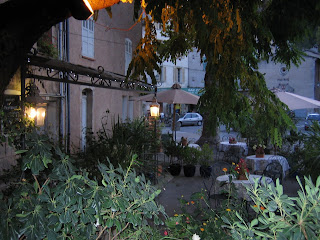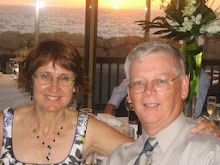
This photo is taken from our front door looking into the garden of the restaurant next door - Bistro Gourmande. Beyond it is the town square and the Bar Centrale where everything seems to happen.
The weather here in Provence (in the Departement du Var) has started to chill quite considerably and quite quickly. When we arrived at Entrecasteaux two weeks ago the temps were still in the mid-20s during the day and we could sit outside to eat dinner. Fran suggested the other day that we may have to turn on the heaters before the end of October - Adrian’s retort - “maybe even before the end of the day”! Coincidentally, on the day that Dot and Jeff departed, we experienced our first Mistral (the strong gusty winds which are typical of Provence at this time of the year) and the mornings and evenings have been very cold. So much for skipping winter whilst in France.
We continue to enjoy exploring some of the beautiful little villages relatively near to Entrecasteaux. They don‘t make the guidebooks, but they are interesting nonetheless for all sorts of reasons - Villecroze - with its grottos and well maintained public gardens, complete with waterfall;
 Chateaudouble so named because it had, not one, but two forts - Castel Diabolico and Castel Duplum - defending it from invaders. It is built at the top of a rocky peak with many rocks supported by wires and netting to protect the houses immediately underneath.. However, there were others, boulders really, with no support, that looked as though they could crash down at any time. Just past Salernes, where we do our internetting and shopping, is Sillans La Cascade which has a waterfall and rock pools about a kilometre from the town - a peaceful spot and apparently a popular family outing on a sunny Saturday afternoon.
Chateaudouble so named because it had, not one, but two forts - Castel Diabolico and Castel Duplum - defending it from invaders. It is built at the top of a rocky peak with many rocks supported by wires and netting to protect the houses immediately underneath.. However, there were others, boulders really, with no support, that looked as though they could crash down at any time. Just past Salernes, where we do our internetting and shopping, is Sillans La Cascade which has a waterfall and rock pools about a kilometre from the town - a peaceful spot and apparently a popular family outing on a sunny Saturday afternoon. 
Then there is Draguignan, a large town where we’ve found two gluten-free stores and it’s only 25 km from home with much to explore. En route home the other day we stopped there for a coffee and the café we happened upon is the oldest in the town - Les Mille Colonnes - established as such in 1760, but the building was originally a house built in 1318!!
Our first social occasion in the village was attending a film evening in the community hall (Salle de L'Age D'Or) - Entrecasteaux in Images. We were welcomed by one of the locals as soon as we arrived - Laurent, a young man who explained to us (he teaches English) that the French media has been very interested in Entrecasteaux and its Chateau, and had provided some of the film. Everyone was arriving inside the hall with plastic cups filled with roasted chestnuts. These were being roasted in a drum (like a barbecue drum) over hot coals. This of course is a novelty for us, so we bought some but couldn't quite master the art of opening them. Fran recognised one of the men from Mass and sat beside him - Bernard, a very friendly and jovial fellow - who chatted with us throughout the evening. The films and the evening were really interesting, providing us with a fascinating insight into the village and the community. They featured several of the locals (some old footage) which provided a source of mirth among the audience, even wolf-whistles at times. The atmosphere was incredibly warm and welcoming despite the almost zero temperatures outside. There is a jazz concert this Saturday in the same hall which we plan to attend.
Sunday was predicted to be a belle journee and so off down south we went to the Coast, a good
 decision, as Sunday is hunting day (wild boar and pheasants) and there was quite a collection of army fatigues, guns and cartridge belts assembling at the bar in the town square as we left. There were also a number of dogs including one inside a car, barking and ready to get on with it. We headed first to St Maxime with all its expensive boats and then on to St Tropez (with its even more expensive boats), famous seaside port renowned for attracting the rich and famous. What were we doing there? Fortunately we arrived around 1:30 pm. It seemed that the St Tropez Classique (fun run) had occurred that morning and the signs alerted us that the roads would be perturbee between 8:00 and 11:30.
decision, as Sunday is hunting day (wild boar and pheasants) and there was quite a collection of army fatigues, guns and cartridge belts assembling at the bar in the town square as we left. There were also a number of dogs including one inside a car, barking and ready to get on with it. We headed first to St Maxime with all its expensive boats and then on to St Tropez (with its even more expensive boats), famous seaside port renowned for attracting the rich and famous. What were we doing there? Fortunately we arrived around 1:30 pm. It seemed that the St Tropez Classique (fun run) had occurred that morning and the signs alerted us that the roads would be perturbee between 8:00 and 11:30.
Infamous person spotted at Plage Tahiti near St Tropez
Fran was immediately on the lookout for any celebs and had only walked a few paces before she saw (might have seen) Anthony La Paglia darting into one of the many little boutique shops which line the narrow streets leading to the port. We stopped for a coffee with the (other) beautiful people at a cafe called Seneqier where, according to that source of all travel wisdom (Lonely Planet), Sartre wrote Les Chemins de la Liberte (Roads to Freedom). We left the cafe crowds and ate our picnic lunch in a sheltered spot on Plage Tahiti (hmm...not quite!) after which we enjoyed a peaceful walk along the coastal footpath before heading homewards. En route, we spied a fort at the very top of a peak (like most of them in France) at Grimaud, a beautiful village.
 The fort was built in the 11th century, used and abandoned several times, the last time around the time of the French Revolution. On that note, Adrian is working his way through the 1100+ page tome - Les Miserables.
The fort was built in the 11th century, used and abandoned several times, the last time around the time of the French Revolution. On that note, Adrian is working his way through the 1100+ page tome - Les Miserables. 
We have received another visit from the elderly gentleman who left us with some photos of Bruny Island and a hand-drawn map of Australia (mentioned in the last blog entry). This time we invited him in and he sat with us for about 20 minutes chatting on to us in French. Fran explained that it was quite difficult for her to understand spoken French as everyone speaks so quickly. He laughed, but it didn't slow him down. Sometimes he would direct his comments to Adrian who was looking back at him with a totally confused look on his face. It didn't deter him as he kept chatting. Fran showed him a photograph of the four generations in her brag book - her Dad, Fran, daughter Georgia and granddaughter Chloe. He told us that he is 90. We certainly engaged on one level, although it was a shame that we couldn't understand everything he was saying. He said that it would be easier if we all spoke Esperanto. We helped him down our steps with the sounds of Bon Soir (Good evening) and A Bientot (see you soon) echoing in the still misty cold of the evening.
The other day on another walk around the village, we climbed to the top of the hill where the 18th century St Anne chapel sits. It provides a fabulous almost 360 degree view of the surrounding region and a birds eye view of Entrecasteaux (see photo below).

As we post this entry we have experience three consecutive day of cold and rain and yes...we have turned the heather on!



















